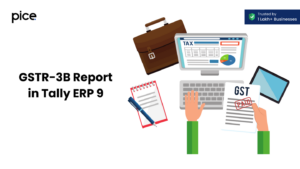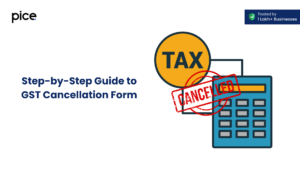Download Commercial Invoice Format Under GST
- 8 Jul 25
- 13 mins

Download Commercial Invoice Format Under GST
Key Takeaways
- A commercial invoice under GST is a legally binding document essential for international trade and customs clearance.
- It includes key details like buyer/seller info, product description, HS codes, tax details, and payment terms.
- Commercial invoices ensure transparency, prevent fraud, and act as proof of sale and payment requests.
- Using a digital commercial invoice format boosts efficiency with offline access, custom branding, and auto-reporting.
- Proper invoice formats support compliance with Indian trade laws and help avoid delays or legal issues in global trade.
In international business, paperwork is crucial, and the commercial invoice format under GST is an important document in trading. This document is evidence of the sale and a critical customs document, facilitating business activities like smooth shipping, proper duty calculation, and seamless transactions across borders.
So, whether you are an importer or exporter, knowing how to prepare and utilise a commercial invoice can save you time and money in your business deals.
Read on to unlock the secrets of commercial invoices and optimise your international trade operations!
What is a Commercial Invoice?
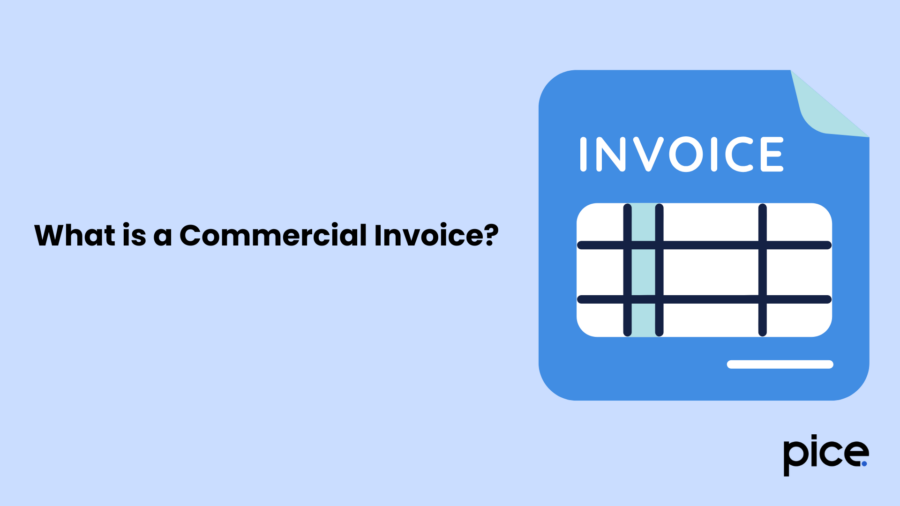
International trade heavily depends on the commercial invoice as one of its indispensable documents. The seller, who functions as an exporter, creates this document while transferring it to the buyer, who functions as the importer, for legal evidence of their trading agreement. Moreover, the document is a detailed description of the customs clearance process because it facilitates authorities in performing tax computations.
A commercial invoice format under GST regulation requires essential data about the description of goods, quantities, prices and sale conditions. Therefore, customs authorities utilise the document to inspect the worth and character of imported merchandise because it holds fundamental status in worldwide trade legal records.
Importance of a Commercial Invoice
A commercial invoice provides transparency between the trading parties and facilitates the shipping process. Here are the importance of a commercial invoice:
- Keeps Proper Records
A commercial invoice is an obligatory document in world trade that assists in the maintenance of proper and full records of international shipments. The document serves as essential proof needed by customs departments and for financial compliance. Therefore, such record-keeping achieves vital importance because it assists audit and financial projection while supporting regulatory compliance.
- Serves as Proof of Sale
Under legal standards, the commercial invoice functions as evidence of transaction conduct since it includes all transactional information like buyer, seller, product details, quantity and worth. It is an important document when there is a dispute in law or payment.
- Facilitates Payment
Being a legal document, a commercial invoice format under GST is important in ensuring payment for the goods sold by the exporter. It states terms of payment, payment due dates, shipping costs and payment amounts, making international shipments transparent and safe.
- Assists in Verification
The importer uses their invoice to verify the shipping documents against the listed characteristics, including product quality, quantity, applicable taxes and price accuracy. Moreover, the confirmation through this document helps prevent delivery errors and supports inventory management functionality.
- Acts as a Payment Reminder
It contains all the details of a regular invoice, like country of origin, applicable taxes and other commercial invoice details. It can be used as an official notice or reminder for outstanding payments. Furthermore, companies tend to utilise it to recover late payments and ensure good cash flow.
- Prevents Fraud
The specific format used for the commercial invoice format under GST helps buyers and sellers avoid disputes and fraud during transactions. Additionally, the system eliminates chances of fake statements, double shipments, issues with payment, and product description misrepresentation.
Indian Laws on Commercial Invoices
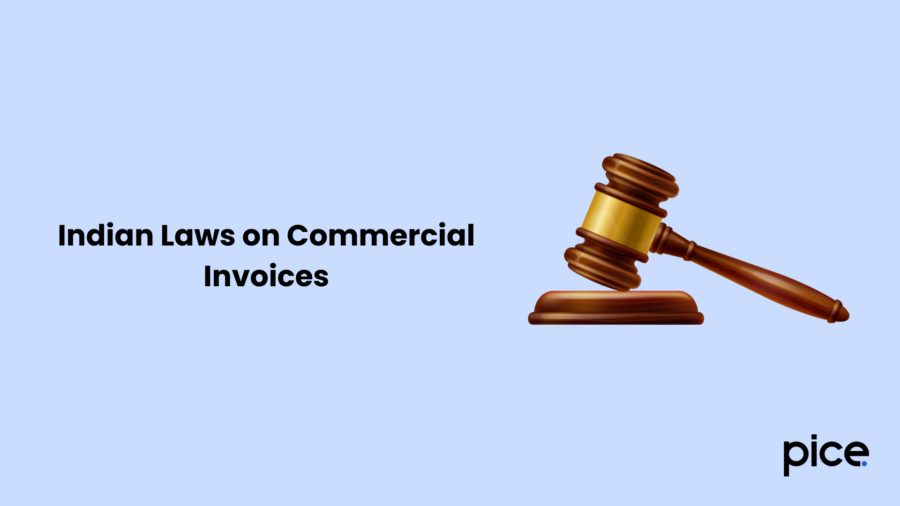
A commercial invoice, as prescribed under Indian law, is the document of import and export operations, defined by the Central Board of Indirect Taxes and Customs (CBIC). According to Circular No. 01/15-Customs, a combined commercial invoice cum packing list would suffice as a legal document since it includes similar information to both documents.
As per Foreign Trade Policy, the tax invoice of international transaction are the bill of lading or airway bill, commercial invoice cum packing list, and the shipping bill. This tax invoice makes your trade follow regulatory compliance, terms of sale, legal compliance, and other common terms for smooth import clearance and export activities.
What are the Contents of a Commercial Invoice?
A commercial invoice must contain particular information to allow successful international trade operations, precise customs clearance and appropriate documentation management. A commercial tax invoice consists of key sections which form its fundamental structure as follows:
- Exporter and Importer Details
Under GST, all business details of international clients for exporters and importers must include name and address information and tax identification numbers. Good visibility and trade regulation business compliance are enabled through this method.
- Goods Description
The shipping of goods needs a specific, detailed description so it remains exact in the commercial invoice document. The customs authorities require the quantity, unit value and total cost to calculate duties and taxes.
- Harmonised System (HS) Codes
Every product should carry an HS code for its international product classification generated by commercial invoice software programs. Accurate Harmonised System codes are an essential tool for easier customs transit management and decreasing the likelihood of transit delays or payment fines.
- Invoice Number and Date
The transaction requires the complete invoice number and the date when this invoice was issued to serve as reference points for tracing.
- Customs and Tax Information
Include all necessary commercial invoice fields like customs expenses and duty taxes, with import taxes to ensure clear communication about additional costs to the importer.
- Payment Terms and Incoterms
Payment terms, Incoterms FOB and CIF, should be defined to clarify financial and logistics duties between business parties.
Difference Between Proforma Invoice and Commercial Invoice
The following table shows the difference between a proforma invoice and a commercial invoice:
| Aspect | Commercial Invoice | Proforma Invoice |
| Purpose | A commercial invoice is the last billing document that confirms the transaction and is utilised for customs and payment processing. | A proforma invoice is a detailed invoice sent to present the buyer with an estimate before finalising the sale. |
| Timing | It is issued after the goods are ready for shipment and the sale is complete. | It is issued before business and trade-related activities, and the sale is confirmed. |
| Legal Status | A commercial invoice format under GST is a legally binding document that confirms the actual sale of goods or services. | It is not legally binding and is issued for informational purposes only. |
| Content | Includes detailed descriptions of goods, final prices, applicable taxes, fees, payment terms, and shipping details. | Contains business records like estimated costs, proposed terms, and may lack full shipping and tax details. |
| Use Case | Used for customs clearance, tax calculation, and as proof of ownership and sale. | Used to assist the buyer in internal approvals, budgeting, or applying for import permits. |
| Payment Request | Acts as an official request for payment from the buyer to the seller. | Does not request payment and is treated more like a quote or offer. |
| Customs Utility | Required by customs authorities to assess duties and taxes and clear the goods for import/export. | Not accepted by customs as it does not confirm an actual sale. |
How to Make a Commercial Invoice?
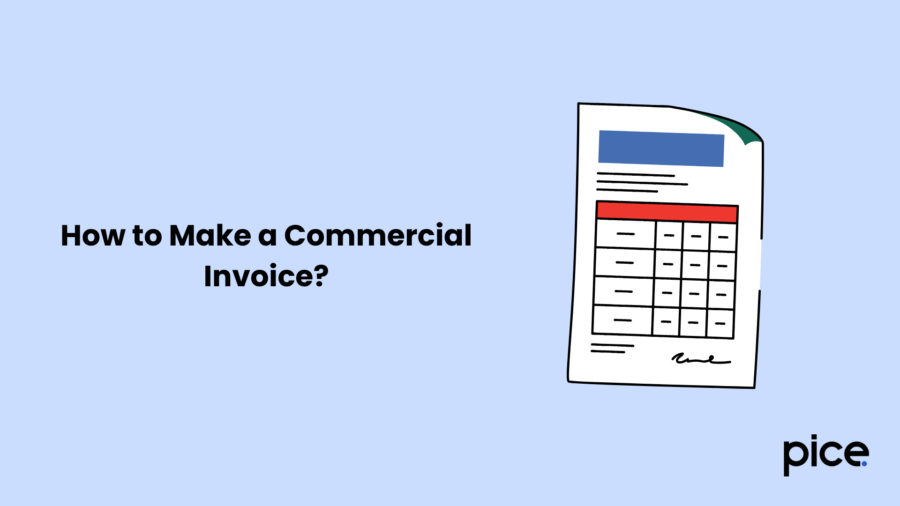
Preparation of a commercial invoice format under GST is vital for international business, as it is a legal document that can aid in customs clearance and enable seamless transactions between buyers and sellers. Below is a step-by-step procedure for preparing a complete commercial invoice:
- Enter Seller and Buyer Details
Provide full details for the seller (exporter) and buyer (importer):
- Business Names and Addresses: Give the official names and street addresses.
- Contact Information: Give phone numbers and e-mail addresses for communication.
- Tax Identification Numbers: Incorporate GSTIN, VAT, or other appropriate tax IDs to ensure business compliance.
- Consignee Details: Mention the consignee details if not the same as the buyer.
- Assign an Invoice Number and Customer Reference Number
Each invoice should have a unique identifier:
- Invoice Number: A sequential number for tracking and record-keeping.
- Invoice Date: The date the invoice is issued.
- Customer Reference Number: Often the buyer's purchase order number or contract reference.
- Include the Terms and Conditions of Sale
Clearly state the agreed-upon terms:
- Incoterms: Determine responsibilities for shipment, insurance, and tariffs (e.g., FOB, CIF).
- Delivery Terms: Identify delivery terms and schedules.
- Specify the Payment Terms
Detail the financial arrangements:
- Payment Method: Bank transfer, letter of credit, etc.
- Payment Due Date: When the payment is expected.
- Bank Details: Include the seller's bank information for remittance.
- Determine the Currency
State the currency in which the transaction is conducted (e.g., USD, EUR, INR). This is crucial for financial clarity and compliance with international standards.
- Include the Shipping Method
Provide details about the shipment:
- Mode of Transport: Air, sea, or land.
- Carrier Information: Name of the shipping company.
- Tracking Number: For monitoring the shipment's progress.
- Mention the Product Details
List comprehensive information about the goods:
- Description: Detailed description of each item.
- Quantity: Number of units per item.
- Unit Price and Total Value: Price per unit and the total amount.
- HS Codes: Harmonised System codes for customs classification.
- Country of Origin: The destination country where the goods were manufactured.
- Detail Miscellaneous Charges
Include any additional costs:
- Freight Charges: Cost of transporting the goods.
- Insurance: Coverage for the shipment.
- Handling Fees: Any extra service charges during the invoicing process
Benefits of Using a Commercial Invoice Format
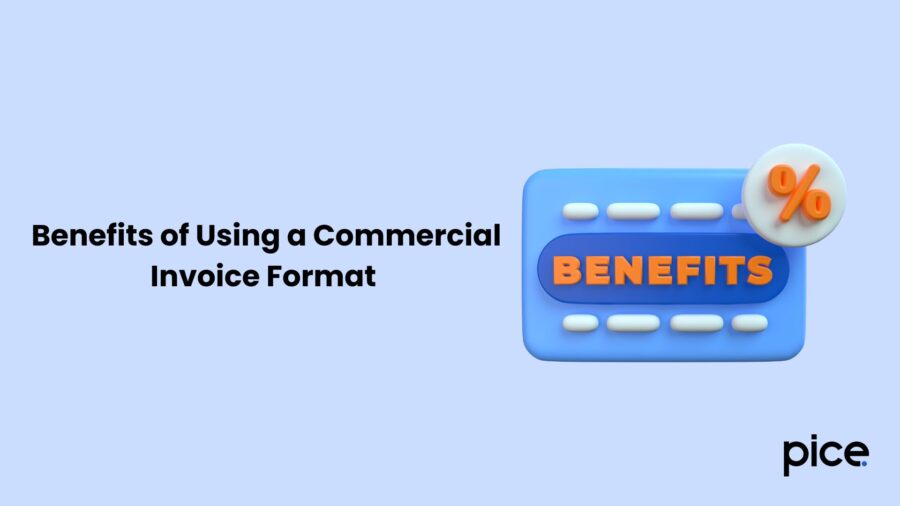
Commercial invoicing must have a proper format to maintain transparency between the trading parties. Here are the benefits of using a commercial invoice format:
- Business Dashboard
The correct design of the commercial invoice format under GST includes built-in business dashboards which present detailed operational insights about the business. Through this dashboard, financial traders can monitor their key business indicators, including sales metrics, payment balances and profit data.
Also, the business dashboard system, present in a properly designed commercial invoice format, lets owners check their pending invoices in addition to tracking inventory totals and monitoring their customers' transaction histories.
Therefore, business efficiency increases while better decision-making and enhanced planning occur when all available information is accessible because action areas and requirements become identifiable.
- Capabilities for Working Offline
A digital commercial invoice format under GST benefits business procedures because it enables work functions offline. Working in remote and low-connectivity locations becomes more convenient with this system. Off-network operation enables users to generate, modify invoices and save their work when they lack an Internet connection.
Moreover, the device successfully links to the Internet and later automatically merges all stored records. Hence, this provides uninterrupted workflow connections and reduces fundamental invoicing operations' dependence on Internet access.
- Invoicing With a Personal Touch
Specific commercial invoice configurations enable businesses to display a professional, trademarked brand image. Moreover, businesses can enhance their invoices by adding their logo and business color schemes, while selecting specific font styles and individual thank-you messages.
Strategic business elements embedded in invoices create enduring customer effects and strong product associations in their minds. Therefore, the GST-compliant commercial invoice format presents professionalism and serious credibility to enhance business relationships with customers.
- Business Reports
Using a correct commercial invoice format under GST makes it possible to develop comprehensive business statistics. The business reports contain information about sales summaries, along with expense analysis, profit analysis, tax reports and stock movement information.
Moreover, the provided information enables business owners to check operations through performance tracking, growth predictions, and financial inspection for leak detection. Reports that receive suitable maintenance are a fundamental element for performing accurate tax filings and conducting audit procedures.
Therefore, report generation automation saves time and reduces errors, facilitating compliance with regulatory requirements.
- The Free Primary Usage for Life
Most invoicing platforms have free lifetime use of their core features. This is perfect for small businesses and start-ups who are wary of costs. With or without free use, users can generate professional invoices, track inventory, and store customer information.
Hence, having a no-charge base version means that all businesses, big or small, can enjoy digital invoicing without worrying about costs.
Conclusion
Overall, a commercial invoice format under GST is a necessary document in foreign trade that promotes transparency, enables quick customs clearance, and acts as legal evidence of a transaction. It maintains proper records, aids in the payment process, and safeguards buyers and sellers against disputes.
Utilising a formal commercial invoice template makes it easier and more professional. With knowledge of its significance and structure, businesses can trade confidently and in compliance with borders.
💡If you want to streamline your invoices and make payments via credit or debit card or UPI, consider using the PICE App. Explore the PICE App today and take your business to new heights.








